Radiant floors can greatly boost your home's value and savings in seven key ways. You'll enjoy lower energy bills due to their efficient heat distribution and zoning capabilities. Your property value will increase, as radiant heating is a desirable feature for buyers. You'll breathe easier with improved indoor air quality, free from circulating dust and allergens. The versatile heating solution works well in various spaces and with different flooring types. Your floors will last longer, thanks to reduced wear and tear. You'll appreciate the silent, comfortable operation and lower maintenance costs. Discover how this innovative heating system can transform your home experience.
Energy Efficiency and Lower Bills
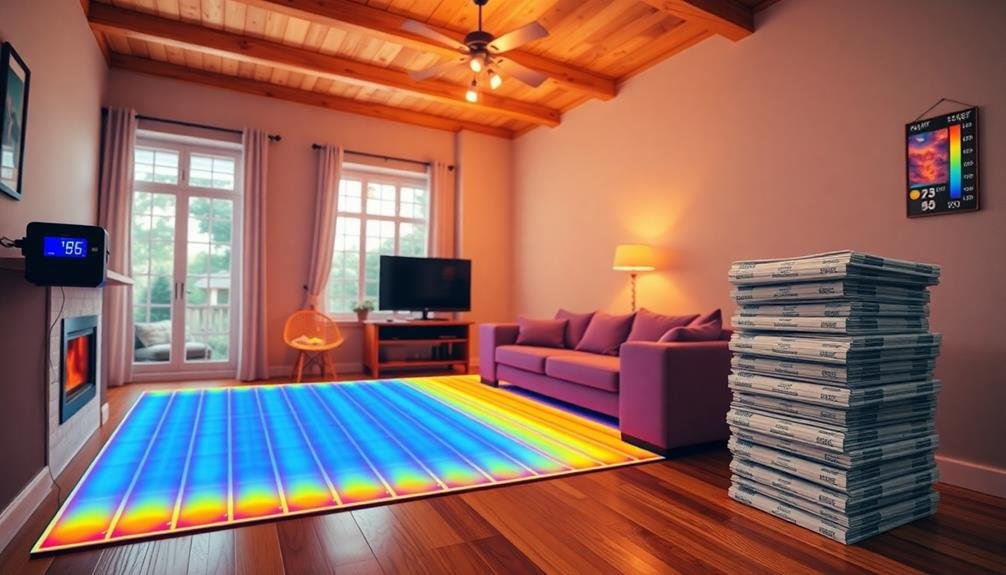
Radiant floors can considerably cut down on energy costs for homeowners. They distribute heat evenly throughout your space, eliminating cold spots and reducing the need for additional heating sources. Unlike forced-air systems, radiant floors don't lose heat through ductwork, making them up to 30% more efficient.
You'll notice the difference in your energy bills almost immediately. Radiant floors operate at lower temperatures than traditional heating systems, yet they maintain a comfortable environment. This means your heating system doesn't have to work as hard, consuming less energy and saving you money.
The efficiency of radiant floors extends beyond just heating. They're compatible with various energy sources, including solar and geothermal, allowing you to further reduce your carbon footprint and energy costs. Additionally, they don't circulate dust or allergens, improving indoor air quality and potentially reducing health-related expenses.
Radiant floors also provide zoned heating capabilities, allowing you to heat only the rooms you're using. This targeted approach prevents energy waste and contributes to even more savings on your utility bills.
Over time, these energy-efficient features can lead to substantial cost reductions, making radiant floors a smart investment for your home.
Increased Property Value
Home buyers are increasingly drawn to properties with radiant floor heating, making it a valuable selling point. If you're considering selling your home in the future, installing radiant floors can greatly boost its market value. Real estate agents often highlight this feature in listings, as it's seen as a premium upgrade that sets a property apart from others.
Radiant floor heating can increase your home's value in several ways:
- Improved comfort: Potential buyers appreciate the luxurious feel of warm floors throughout the house.
- Energy efficiency: The system's ability to reduce heating costs is attractive to environmentally conscious buyers.
- Modern technology: It's perceived as an advanced, high-end feature that adds to the home's overall appeal.
When you invest in radiant floor heating, you're not just improving your current living situation; you're also making a smart financial decision for the future. The added value often exceeds the initial installation costs, providing a solid return on investment.
Additionally, homes with radiant heating tend to sell faster than those without, giving you an edge in a competitive real estate market. It's a feature that can make your property stand out and command a higher price when it's time to sell.
Improved Indoor Air Quality
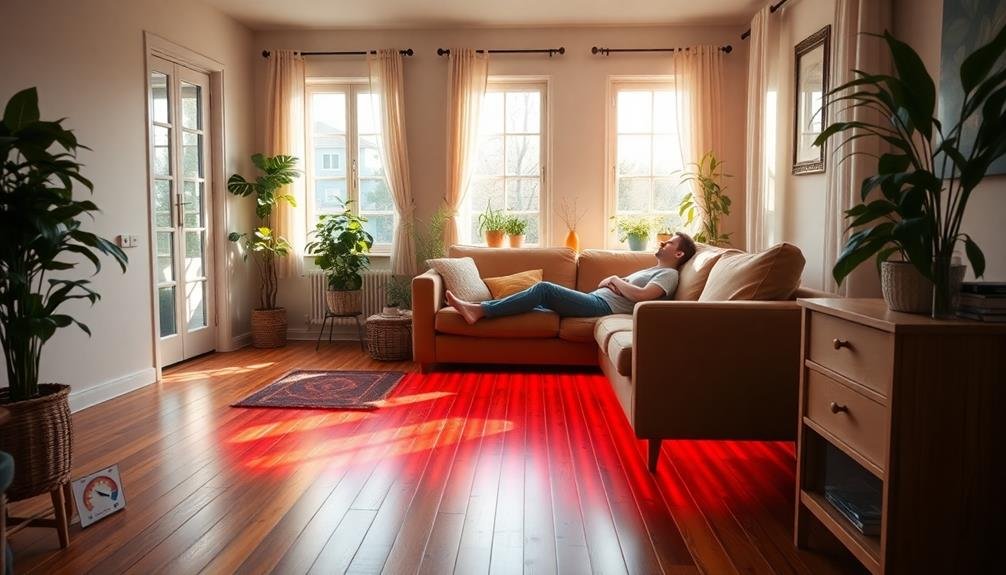
When it comes to indoor air quality, radiant floor heating systems stand out from traditional forced-air heating methods. Unlike forced-air systems that circulate dust, allergens, and other particles throughout your home, radiant floors heat without moving air. This means you'll breathe cleaner air and experience fewer respiratory irritations.
You'll notice a considerable reduction in dust accumulation on surfaces, as there's no constant air movement to stir up particles. This can be especially beneficial if you or your family members suffer from allergies or asthma.
Additionally, radiant floors eliminate the need for ductwork, which can harbor mold, bacteria, and other contaminants that affect air quality.
Another advantage is the reduction of dry air typically associated with forced-air systems. Radiant heat maintains a more consistent humidity level, preventing the dryness that can lead to skin irritation and respiratory discomfort.
You'll also avoid the unpleasant odors that can sometimes accompany forced-air heating when dust burns on hot elements or mold grows in ductwork.
Versatile Heating Solution
A home's heating system should adapt to various spaces and needs, and radiant floor heating excels in this regard. You'll find that this technology can be installed in virtually any room, from bathrooms and kitchens to living areas and basements.
It's particularly effective in spaces with high ceilings or large windows, where traditional heating methods often fall short.
Radiant floor heating offers customizable zoning options, allowing you to heat different areas of your home independently. This means you can maintain comfort while saving energy by adjusting temperatures based on room usage and personal preferences.
The system's versatility extends to various flooring materials, including:
- Tile and stone
- Hardwood and engineered wood
- Carpet and laminate
You're not limited by flooring choices when opting for radiant heat. It's also compatible with different heat sources, such as electric, hydronic (water-based), and even solar-powered systems.
This flexibility allows you to choose the most cost-effective and environmentally friendly option for your home. Whether you're building a new house or renovating an existing one, radiant floor heating can be seamlessly integrated into your design, providing efficient and comfortable heating throughout your living space.
Extended Flooring Lifespan
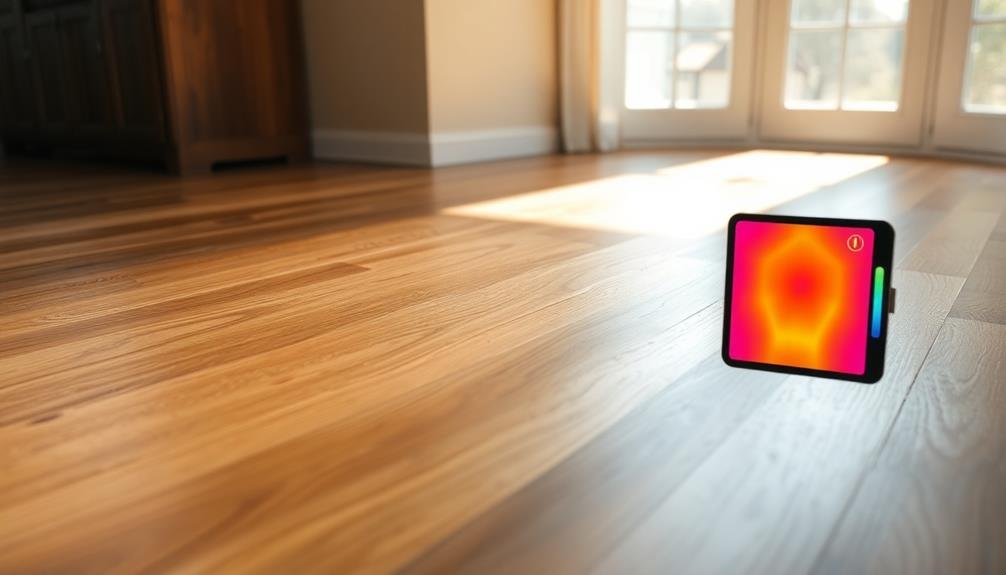
Your radiant floor heating system can considerably extend the life of your flooring.
You'll notice reduced wear and tear on your floors, as the even heat distribution eliminates the need for air circulation that can carry abrasive dust particles.
Additionally, the consistent warmth helps protect your flooring from moisture damage by maintaining a stable temperature and preventing condensation.
Reduced Wear and Tear
Radiant floors spare your flooring from the constant stress of temperature fluctuations and foot traffic. Unlike traditional heating systems that create hot and cold spots, radiant heating distributes warmth evenly across your floor's surface.
This consistent temperature prevents expansion and contraction cycles that can lead to warping, cracking, or separation in hardwood and tile floors.
You'll notice less wear and tear on your flooring materials over time. Radiant heat eliminates the need for floor vents, reducing the risk of scratches and scuffs caused by furniture placement or foot traffic around these areas.
Additionally, the absence of forced air circulation means less dust and debris settling on your floors, minimizing surface abrasion.
The benefits of reduced wear and tear include:
- Longer-lasting flooring materials
- Fewer repairs and replacements needed
- Maintained aesthetic appeal over time
Protection From Moisture Damage
Moisture-related issues often plague traditional heating systems, but radiant floors offer a robust defense against these problems. By eliminating the need for ductwork and vents, radiant heating systems considerably reduce the risk of moisture accumulation and subsequent damage to your home's structure.
You'll find that radiant floors help maintain a consistent humidity level throughout your home, preventing the formation of condensation that can lead to mold and mildew growth. This is particularly beneficial in bathrooms, kitchens, and basements, where moisture is more prevalent.
The even distribution of heat also helps dry out any moisture that does accumulate, further protecting your flooring and subfloor from water damage.
Additionally, radiant heating systems don't circulate dust, allergens, or moisture through the air like forced-air systems do. This means you're less likely to experience issues with warping, cupping, or expansion of hardwood floors due to fluctuations in humidity.
The absence of air circulation also reduces the risk of moisture being trapped in carpets or underneath area rugs, extending the life of your floor coverings and maintaining their appearance for years to come.
Silent and Comfortable Operation
Whispering warmth emanates from radiant floors, providing a uniquely silent and comfortable heating experience. Unlike traditional forced-air systems, you won't hear the hum of a furnace or the rush of air through vents. This silent operation creates a peaceful environment, perfect for relaxation or concentration.
You'll notice the comfort difference immediately. Radiant floors distribute heat evenly from the ground up, eliminating cold spots and drafts. Your feet will stay cozy on warm surfaces, and the consistent temperature throughout the room enhances overall comfort.
The absence of blowing air also means:
- Less dust and allergens circulating in your home
- No dry air issues that can cause skin irritation or respiratory discomfort
- Improved indoor air quality for better health
Radiant floors offer zone control, allowing you to customize temperatures in different areas of your home. This personalized comfort extends to all occupants, as the even heat distribution reduces temperature discrepancies between the floor and ceiling.
You'll appreciate the invisible nature of radiant heating. Without visible vents or radiators, you'll have more freedom in furniture placement and room design, creating a clean, uncluttered look that adds to your home's aesthetic appeal.
Reduced Maintenance Costs
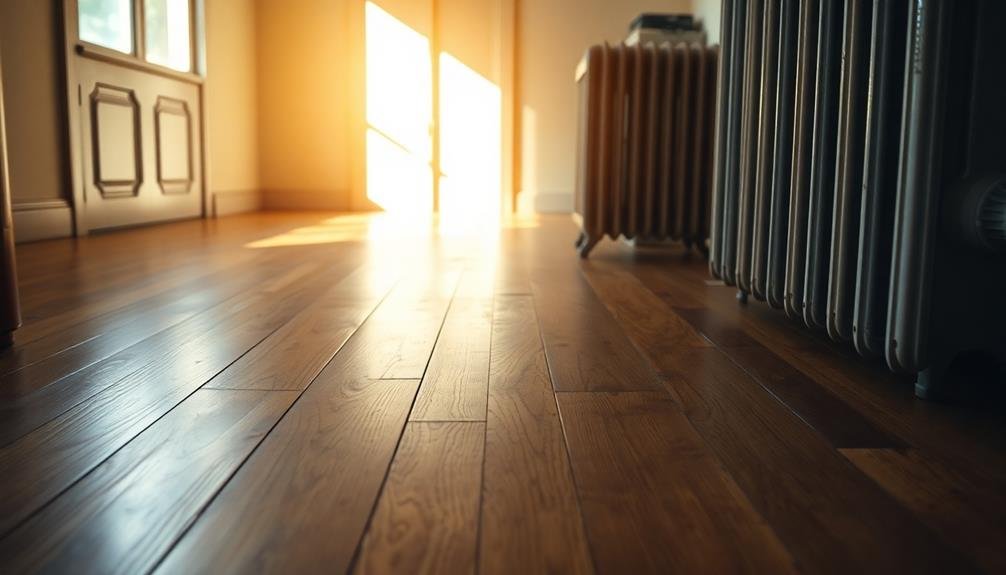
Beyond the comfort and silence, radiant floor heating systems offer another significant advantage: reduced maintenance costs. Unlike traditional forced-air systems, radiant floors have fewer moving parts, which means less wear and tear over time. You won't need to worry about replacing filters, cleaning ductwork, or servicing complex components like furnace burners or blower motors.
Radiant systems typically last longer than conventional heating methods. The pipes or electric elements used in these systems can endure for decades with proper installation and care. This longevity translates to significant savings on replacement costs over the life of your home.
You'll also save on routine maintenance visits. While it's still wise to have your system checked periodically, these inspections are less frequent and less involved than those required for traditional HVAC systems. The simplicity of radiant heating means fewer potential points of failure, reducing the likelihood of unexpected repairs.
Moreover, the absence of ductwork eliminates a common source of energy loss and air quality issues. You won't need to invest in duct cleaning or sealing, further reducing your long-term maintenance expenses.
Frequently Asked Questions
How Long Does It Take to Install Radiant Floor Heating?
You'll find that radiant floor heating installation typically takes 1-3 days for a single room, or 3-7 days for a whole house. It depends on your home's size, floor type, and whether it's new construction or retrofitting.
Can Radiant Floor Heating Be Installed in Existing Homes?
Yes, you can install radiant floor heating in existing homes. You'll need to remove existing flooring and possibly raise floor height. It's more challenging than new construction, but it's doable with proper planning and professional installation.
What Types of Flooring Materials Work Best With Radiant Heating?
You'll find that ceramic tile, porcelain, and natural stone work best with radiant heating. They conduct heat well and won't warp. Engineered hardwood and luxury vinyl are good options too. Avoid thick carpets, as they'll insulate the heat.
Are There Any Health Concerns Associated With Radiant Floor Heating?
You'll be glad to know that radiant floor heating doesn't pose significant health concerns. It's generally safe and can even improve indoor air quality by reducing dust circulation. However, guarantee proper installation to avoid any potential issues.
How Does Radiant Floor Heating Compare to Other Heating Systems in Cost?
You'll find radiant floor heating's upfront cost higher than traditional systems. However, it's more energy-efficient, potentially saving you money long-term. It's also zone-controllable, allowing you to heat specific areas, further reducing your energy bills.
In Summary
You've seen how radiant floors can transform your home. They'll slash energy bills, boost property value, and improve air quality. You'll enjoy versatile, silent heating that's kind to your flooring. With lower maintenance costs, you're looking at long-term savings. Don't overlook the comfort factor—warm floors on chilly mornings are priceless. By investing in radiant flooring, you're not just heating your home; you're enhancing your living experience and financial future.

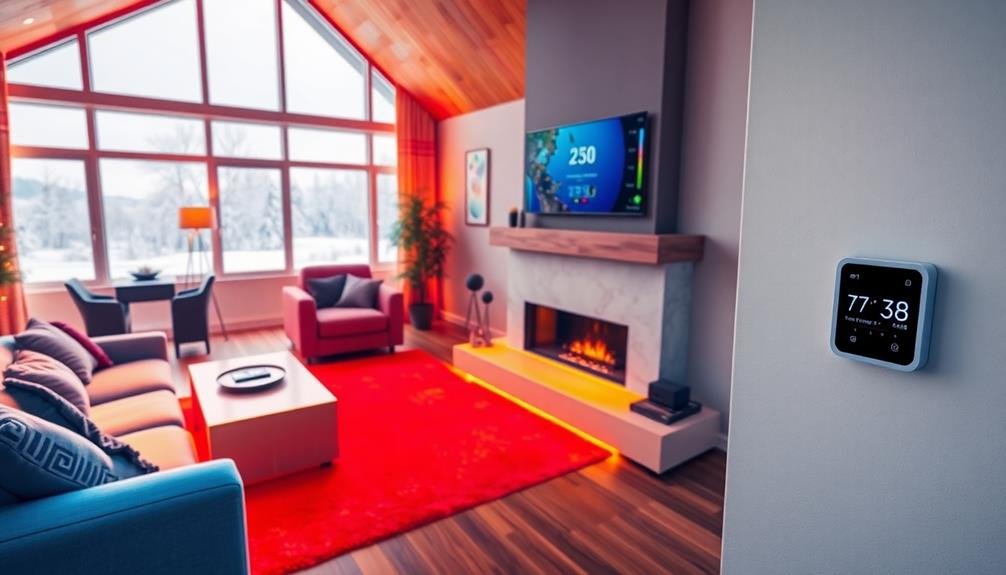



Leave a Reply